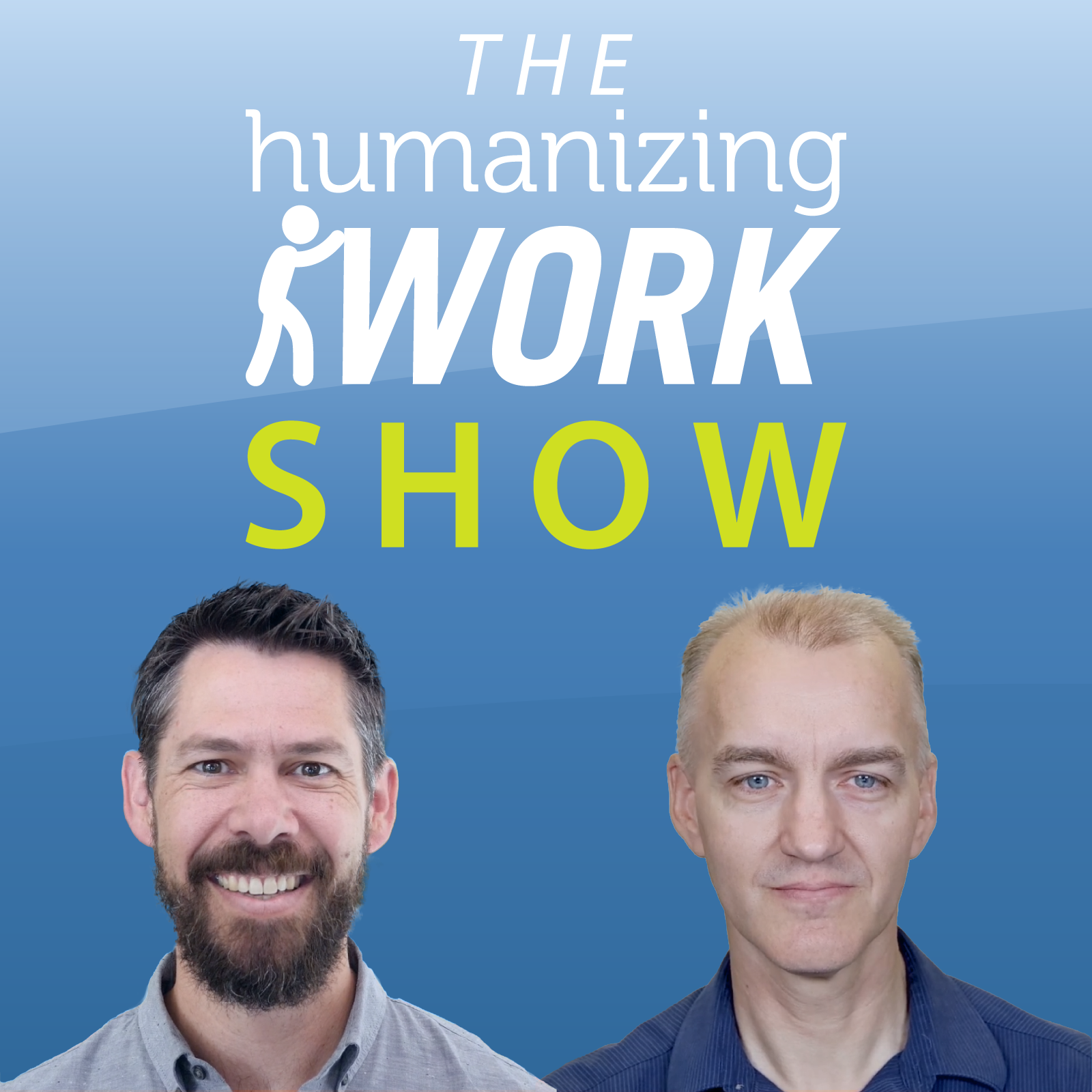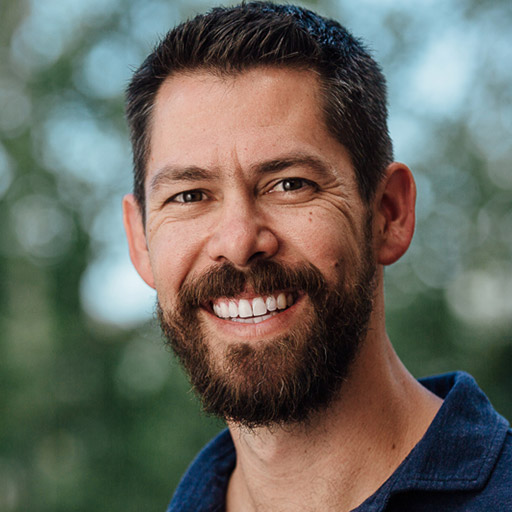Richard Lawrence
Welcome to the Humanizing Work Mailbag, where we answer questions from the Humanizing Work Community!
Today’s mailbag question is a different kind of question. Someone reached out to Peter to ask if he’d shared publicly a story that he normally shares in our Leading Organizational Transformation class, about a blunder he made with a CEO some years back. Turns out he hadn’t. So, Peter’s going to share the story here and I’ll interview him about some larger lessons from it.
Peter Green
Before we jump into that episode, we want to help you with whatever challenges are most frustrating you right now. If you’re feeling stuck on something, whether that’s trying to take a more human-centric approach to your work, trying to make your product or business outcomes better, or if you’ve just got a more tactical, process-related question, let us know about it. Send us an email at
[email protected] with a few details about your situation, and we’ll share how we might think through it right here on the Humanizing Work Show.
Richard
And just a quick reminder, please rate and review the Humanizing Work Show in your podcast app, or if you’re watching on YouTube, please subscribe, like, and share today’s episode if you find it valuable to you. We appreciate your help spreading the word about the show.
Peter
And if you want to get access to more of the content we produce, not just the show, you can sign up for our newsletter where we share one key idea every week. Sign up at humanizingwork.com/hwnews.
Richard
Alright, on to today’s topic. When we’re teaching the Leadership Circle leadership development model in our Leading Organizational Transformation class, Peter often shares a story about a time when his own reactive tendencies caused him to hit the limits of his leadership in a vivid way.
Peter
Yeah, and I usually will share a little bit of backstory here because it helps provide the context for what was going on in that conversation with that CEO.
So this was at the time when Adobe was just beginning to adopt a subscription model. So they were moving from perpetual licensed boxed software to subscription based– kind of web based– downloadable software. And the first release of that Creative Cloud subscription model was difficult, like any big business shift like that. And there were several teams across the company that were collaborating and coordinating their efforts to be able to figure out how to run a subscription business.
And so I had been asked to do a retrospective after that first release of the Creative Cloud with all of the teams responsible for identity management and subscription pricing and all of those components. And so I had gone kind of around the world (there were multiple offices in different areas in the world) and done a retrospective at each of those sites.
And in those retrospectives, we collected kind of two categories of next steps. One category was “What are actions that the team could take and that would make a big difference in the next release?” And then there were other ones which were “What proposals do you have for things that you need leadership support on?” And so we had them use a template to make that a very concrete thing where we need, you know, this from leadership or this organizationally.
And after all those retrospectives, I summarized those proposals for leadership and a big presentation and shared that with – you know– several different leaders at the company. And not a lot happened. I think there were three kind of big requests. And one of them was relatively straightforward. And it involved hiring a person to kind of do product ownership across all those things to make decisions.
Two of them were more cultural changes, ways that we interacted with leadership, ways we structured teams. And after several months, there was no change in those two areas. So I was frustrated about that. There was a lot of kind of frustration and venting that came out, and I felt like I was the lightning rod of all of the difficulty for that first release since I was conducting those retrospectives.
And then there was a big banquet being held where people that had been granted a patent by the U.S. Patent Office were invited to this dinner to celebrate the patent being issued. It's usually a seven or eight year lag from when you submit a patent to when, if it gets to the patent office, you actually get the patent granted.
And a couple that I had submitted years before that had actually gone all the way through and so it was fun to go to that banquet and there was no assigned seating. So I just kind of wandered in and sat down at a table. And a few minutes later, Shantanu Narayen, who was the CEO at the time (currently still the CEO), Shantanu sat down at the same table and we had our dinner and there was a big presentation; and after the dinner, Shantanu, to his credit, turned to the table and said, “You know, how often do you get the CEO's ear? What do you want to talk about?” And it was kind of quiet at the table for a minute. And the frustration from that lack of action, from my standpoint, on those retrospective items started to bubble up a little bit.
And I said, “You know what? I'm going to take a stand for all those people that were frustrated.” And I turned to Shantanu, and I said, “Well, Shantanu, as the retrospective report made clear, there's a culture of fear at Adobe, and I'm wondering what you're going to do about it.” So that was the blunder. Yeah, you know, I would say that Shantanu actually handled that kind of critical and somewhat arrogant response pretty effectively, right?
He listened. He explained his viewpoint on it, but it didn't really lead to us having many ongoing conversations about how we could make meaningful change going forward. And, you know, as I've reflected back on that, I always wish that's one of those things where I wish I had a do over and I feel like I need to now publicly apologize to Shantanu for coming across so critically in that opportunity where there were probably a lot of better options for what I could have said, ones that would have led to better outcomes and really where I wasn't just being quite as big a jerk as I was in that moment.
Richard
So how else, in retrospect, could you have handled it?
Peter
Well, the reason I tell this story in this class is because we're teaching a model called the Leadership Circle. And in the leadership circle there are kind of two stages of development, adult stages of human development that all adults, you know, might pass through depending on their circumstances or might be in at any given minute.
And there's a 360 associated with that model. And I had taken the 360, you know, when I first heard about it, just to kind of see, “How does this model work?” And it was really powerful for me. When I took the 360. There are two tendencies that are called reactive tendencies and those tendencies were “Critical” and “Arrogant.” Like those were my strongest reactive tendencies. When people, you know, people that I knew and had worked with me or for me gave me feedback.
And I remember in the coaching debrief from that, that my coach, in future sessions, kind of was helping me understand, you know, where's that coming from, What could I do about it? And one time he asked me on a call, “What does it feel like right before you go ‘Critical, arrogant’?” And I said, “Well, it feels frustrating.” And he said, “No, like in your body, where do you feel it?” And I remember saying, “I feel it like in my chest tightens. Up my neck. It's a little bit hot. Like, that's how I know. But I'm frustrated, right? Those are the physical signals of that in my body.
And he said, “All right, so here's what I want you to practice. I want you to practice being aware of that feeling. And then as soon as you feel that feeling, I want you to pick a creative competency, one that would be in the next stage of development that you can remind yourself of.” And through that coaching debrief, I decided to pick two creative competencies.
One of those is called “Purposeful Visionary,” And one of those is called “Caring Connection.” One is kind of on the task side of the leadership circle, one on the relationship side of the leadership circle. And I thought that those two areas were lower than I wanted on the 360, when I got my feedback.
I always felt like I cared a lot about people. I always felt like I had a strong purpose and vision for the work that I did, but that clearly wasn't coming across. And so I decided to pick when I started to feel that tension, that frustration building up, I decided to just in my head, say “purposeful, visionary, caring, connection, purposeful, visionary, caring connection,” kind of like a mantra and see what other options that gave me in that moment of frustration.
And so if I had it to do over again, I could have picked either one of those with Shantanu when he said, “What do you want to talk about?” I could have gone purposeful and visionary and said, “Well, I'm so excited about the opportunities we have as a business to deliver more frequently to our customers and really accelerate creativity in the world and, you know, I would love to talk more about that and talk to, you know, talk about what I've been doing in my role as the transformation leader and where we might be able to help each other out; because I think we have a shared goal here.”
Right. I could have gone there. I could have gone to “Caring Connection,” and said, “Shantanu, you just led a major business transformation with a huge company and that is a high risk tight wire walk. That must have been exhausting and at times terrifying for you. How could we be of more service to you through that type of difficult leadership challenge?”
Richard
Is this you avoiding the issue you actually want to talk about here?
Peter
The great thing is that neither one of those actually avoids the issue. It creates the opportunity to have a more in-depth conversation for either one of those. So it opens up a conversation. And the way that I did it closed off the conversation. Shantanu, I'm sure, felt a little defensive in that moment.
And thankfully he reacted in a pretty creative way. From the leadership circle standpoint, his response was, I would say, kind of systems thinking on the creative side. It was “Purposeful Visionary.” And he actually did have his chief of staff follow up with me to have a call just to see, you know, “Is Peter OK?” I think– but it was kind of “Let's see if there's something there.”
But that ended up fizzling out pretty quickly. So I was probably still, even in those follow up calls with the chief of staff, it really didn't go much further because I think I was probably still showing up in those as somewhat “Critical, Arrogant.” So you had to play a little bit of a longer game if you were going to show up on the more creative side.
Yeah. And I think this is a theme that I noticed coming up over and over again in Effective leadership. It's really easy to get caught up in the moment and kind of short term, “How am I feeling right now?” Versus, “What is the thing that I'm sort of feeling like I need right now versus what is the long goal here?”
And that's an example actually of “Purposeful, Visionary,” and kind of “Strategic Thinker.” Another creative competency is to say this is part of a much bigger thing. This is one conversation. How might I slot that into a bigger purpose for how we work together?
Richard
As you've continued to work on this over the years, especially that shift from “Critical Arrogance” to “Purposeful Visionary” and “Caring Connection,” and just becoming more aware of how you're beginning to react and being more mindful about it; how else have you seen that shift show up in your leadership and what are some of the effects of that?
Peter
Well, one of the more powerful ways that has shown up is not at work, but how I show up for my family. I remember going on a business trip once and being frustrated with one of my kids when I got back.
And, you know, I think they had said, “Hey, I'm going to do these things while you're gone.” I got back. Those things weren't done. I was reacting in that moment like “Critical and Arrogant” again. “When I was your age, I was already X, Y, Z,” and I felt those bodily sensations of my chest tightening up– a little bit of heat in the neck.
And I said, “Oh, you mean I've got to do it at home, too? Okay, what does ‘Purposeful Visionary’ look like here? What does ‘Caring Connection’ look like here?” And instead of going to “Critical Arrogant,” I thought for just a moment, like, “What is my vision for my relationship with my kids? What do I want that to be like now? What do I want that to be like in the future?” And I thought, “I want to have an open relationship with my kids where they can tell me things. ‘Caring Connection’. I wonder what's going on for my kid right now where those things actually didn't happen. And even though he seemed kind of fired up about doing them, what's going on there?”
And that opened up a much deeper conversation than I otherwise would have had. And he was willing to share some challenges he'd been having that he had never shared with me or his mom prior to that, that really opened up a new depth to our relationship and a way that we could actually help him in those things that he was struggling with.
Richard
What advice do you have for other leaders as they encounter situations where they're frustrated, maybe frustrated with someone else that they're in a meeting with?
Peter
Yeah, I think the first bit of advice is that there's probably never going to be a world where you don't get frustrated and somebody doesn't do something that either intentionally or unintentionally appears just kind of mean or unthinking or even a bit of an attack.
And so just to be aware that I don't care what level of leadership you've attained in your life or personal awareness, you're still going to have those moments where you're frustrated and you're mad. I had one of these just recently where I got really mad at a situation and I had to think for a minute, kind of “Purposeful and Visionary, Caring Connection.”
“I wonder what's going on for that person. What's my vision for how we interact in the future?” And what that did was shifted my, I think, emotions from angry because I was pretty hopping mad in that specific situation. Like, I don't remember being more angry in a while. Like I had a hard time sleeping that night, kind of mulling it over.
But as I mulled it over, I was able to kind of process it and shift from angry to curious– wonder what's going on for that person that's causing them to communicate in this way right now. We just had a recent call with another really effective leader, and that leader was describing a very similar situation where she felt like somebody had really broken trust with her and kind of gone back on their word.
And at first she was hopping mad. And then as she processed it a little bit, she thought, “Huh. I wonder what's going on for them that caused them to behave that way.” And so I think that that's a pattern. But you have to have just some space before you react. And so the advice I would have for leaders is to figure out how to create just a little bit of space between you're feeling a certain way, you need some way to block the initial reaction or to reconsider. “Block” is probably the wrong word there, where you’re just bottling it up, although I will say that in that situation I mentioned earlier when I was really frustrated, I typed an email to that person where I expressed and vented and then I cc it to a couple of people that I know that would understand what was going on. And then I deleted the original person's email from it and just sent it to the CC and said, “Hey, here was the email I was going to type.”
I just needed to vent, that's all. So I kind of got it out of my system without being reactive with that person, and that actually cleared some space for me to think, “How do I really want to respond? And what would be a great outcome here for both of us, not just for me, where I feel better or I feel like that person apologized?”
I realized I didn't really need that. I really just needed to be more empathetic for “What are they going through?” And sure, maybe that is a problem for them that they communicate that way in general. Or maybe they really were being a jerk to me. I don't know. But it doesn't matter anymore to me. I don't feel like they need to apologize.
I just get curious and say, “I wonder what's going on for them that causes them to behave that way from time to time.”
Richard
Thanks for sharing that, Peter. That I think will be really useful. Please like and share this episode if you found it useful and keep the questions coming. We love digging into tough topics, so send them our way: mailbag@ humanizingwork.com.




